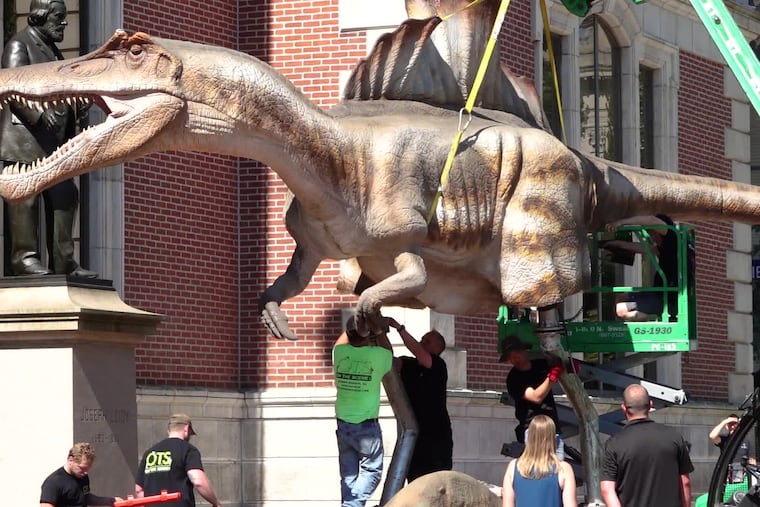Jurassic Parkway: A 45-foot-long dinosaur crosses the Ben Franklin Bridge into Philadelphia
The theropod is one of 11 lifelike robotic dinosaurs coming to the Academy of Natural Sciences.

It’s hard to imagine dinosaurs roaming the streets of Philadelphia. But in the immortal words of Dr. Ian Malcolm of Jurassic Park fame, “Life, uh, finds a way.”
Just after sunrise on Wednesday morning, a Spinosaurus was found staring down cars and bystanders as she trekked from Somerdale, N.J., to the Ben Franklin Parkway. Along the way, the 2,100-pound dinosaur swiveled heads down I-295, around City Hall, and in front of the Philadelphia Museum of Art.
Baring a full set of razor-sharp teeth, the carnivore was chained safely to a flatbed truck, evoking not panic but celeb-spotting awe. Morning joggers stopped in their tracks, mouths agape. Pedestrians whipped out smartphones split-seconds after catching a glimpse of the brown fin arching out of its spine. Cars honked. Tourists cheered. One traffic cop cocked his head, right ear almost to his shoulder, completely dumbfounded by the giant, crocodile-headed creature passing through the intersection at Eighth and Arch.
“We’ve escorted everything from tanks to naval guns and everyone from the president to the pope,” said Dave McWilliam, one of several police escorts clearing traffic for the Spinosaurus en route from a storage facility. “But this marks the very first dinosaur.”
While perhaps not as identifiable as the pope, the 45-foot-long theropod will be presiding over Philadelphia for the next several months as the largest dinosaur in the Academy of Natural Sciences’ “Dinosaurs Around the World” exhibit. It will open Sunday, June 30.
The Spinosaurus is joined by 10 other dinosaurs in the six-month exhibit. Find her roaring outside the museum, flanked by a slightly smaller, spiky-necked Amargasaurus.
Inside, “Dinosaurs Around the World” transports visitors back 200 million years, to when the world’s dinosaurs lived on one super-continent, Pangaea, before the Earth’s tectonic plates splintered it apart.
The first stop of the adventure falls in the forests of Argentina, where a 19-foot-long, 5-foot-tall Herrerasaurus swivels its olive-green head and blinks its fiery eyes. It’s one of the earliest dinosaurs in existence, and the oldest in the 4,800-square-foot exhibit.
“The dinosaurs are all made with brand-new, top-of-the-line technology, so all of their movements are really smooth and natural,” says Jennifer Sontchi, the Academy’s senior exhibits director. Each dinosaur’s backdrop mimics its native environment. “It allows you to see them as the animals they are and not the monsters of which they’re often portrayed.”
Most of the models, such as the ready-to-pounce Velociraptor and the docile Protoceratops, are true to size. The lean Velociraptor — characteristic claws gleaming, tail swaying, jaw chomping — resembles a predatory ostrich. The Protoceratops, blinking balefully, more like a baby elephant.
Scattered throughout, graphic displays dive into the evolution of Pangaea and its affect on the dinosaurs. When the reptiles first appeared, there were only about 10 different types. As land drifted into different latitudes — causing drastic climate changes — new species proliferated. Today, paleontologists have discovered more than 1,000 types.
Time moves as one tours the exhibit, winding down to the end of the Cretaceous Period, when dinosaurs became extinct 66 million years ago. It’s believed by most scientists that a six-mile-wide asteroid crashed into the Gulf of Mexico, eradicating all dinosaur life — save for the birds. (Yes, all present-day birds are considered dinosaurs.)
It’s hard to resist pulling out your phone to snap a shot of these realistic robots. As a crane slowly maneuvered the Spinosaurus to the sidewalk in front of the Academy, several sweaty runners posed for selfies, while kindergartners stopped to point and giggle.
“You walk out in the morning with a latte in your hand, and suddenly there’s a dinosaur in front of you,” said McWilliam, standing next to a scaly foot the size of a mailbox, waiting to be attached. “It’s just something you’d never expect.”
June 30 through Jan. 20, 2020, Academy of Natural Sciences of Drexel University, 1900 Benjamin Franklin Pkwy., $20.95-$24.95 plus $7 for “Dinosaurs Around the World,” 215-299-1000, ansp.org